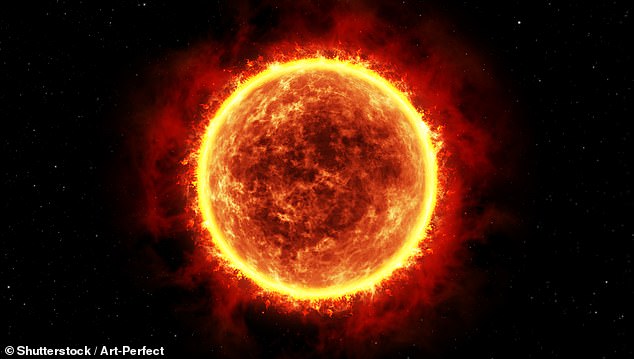For all the chaos going on down here on Earth, it’s easy to forget that we live in a volatile galaxy full of formidable dangers.
From space rocks flying at thousands of miles per hour, to black holes that could rip our planet apart, sometimes it’s best not to think about them.
But what would actually happen to the human body if we perished at the hands of these wild astronomical phenomena?
MailOnline spoke to experts to find out – and to see if there’s any chance of them actually occurring while humanity still exists.
Before any of them happen, Homo sapiens could be responsible for their own demise – likely by creating dangerous AI or the emission of greenhouse gases.

MailOnline looks at five gruesome deaths that could happen due to various astronomical phenomena, from being swallowed by a black hole to a collision with another galaxy
WHAT IF THE SUN DIED OUT?
Scientists estimate that our sun is about 4.5 billion years old – about halfway through its anticipated 9 billion or 10 billion year-long lifespan.
When it starts to die, the sun will expand into a red giant, becoming so large that it will engulf Mercury and Venus, and possibly Earth too.
Of course, in another 4 or 5 billion years’ time humans will likely be long gone, likely wiped out by a climate disaster or an asteroid impact.
However, in the event that we’re still here when the sun dies, the effects would be felt immediately and we would suffer a speedy demise.
‘Assume the sun decide to quit, we would follow very quickly,’ Albert Zijlstra, a professor of astrophysics at the University of Manchester, told MailOnline.
‘The bottom line answer is you’d freeze to death.’
According to Professor Zijlstra, the closest Earth has seen to such an event was the era of ‘snowball Earth’, some 700 million years ago.
‘The entire world was frozen and the sea was covered in a kilometer thick ice from pole to pole, lasting 50 million years,’ he said.

When our sun starts to die, it will expand into a red giant star, becoming so large that it will engulf Mercury and Venus, and possibly Earth too (artist’s impression of red giant)
‘Not much survived life that – and that was with the sun almost as bright as it is now.’
Even if we somehow survived the cold for a few days, plants and crops would die due to the lack of sunlight for photosynthesis – and we would surely starve.
Thankfully, the sun is ‘remarkably stable’ and in no danger of disappearing, Professor Zijlstra added – and is actually very slowly getting brighter.
‘It is not perceptible on human timescales, but give it a billion years and it becomes very noticeable,’ he said.
WHAT IF EARTH FELL INTO A BLACK HOLE?
Perhaps one of the scariest features of the universe are black holes – regions of spacetime where gravity pulls so much that even light can not get out.
Black holes act as intense sources of gravity that hoover up surrounding dust and gas, as well as planets and even other black holes.
They are often described as ‘destructive monsters’ because they tear apart stars, consuming anything that comes too close, and hold light captive.
With light unable to escape black holes, Earth would have little chance either.
Xavier Calmet, a professor of physics at the University of Sussex, said the gravitational force of a black hole would become so strong that we would experience ‘spaghettification’.

Pictured, the black hole at the heart of the galaxy Messier 87 (M87). The stunning image was released earlier this year
‘Your body will be stretched into a shape similar to that of a long pasta until it is reaped apart by the strong gravitational force,’ Professor Calmet told MailOnline.
‘I can’t imagine that this would be pleasant – it would happen rather quickly, so if painful, it is unlikely to last long.’
Dr David L Clements, a senior lecturer at Imperial College London’s physics department, said ‘the end would likely be quick’ if falling into a black hole.
‘It could come from asphyxiation if the atmosphere is stripped, or from the process called spaghettification where tidal forces stretch everything out into long strings – maybe briefly painful.’
Thankfully, the chances of Earth ever being swallowed by a black hole are ‘nearly zero’, according to Dr Clements.
‘The fact that we’re still here shows that this hasn’t happened over the whole history of the Earth,’ he told MailOnline.
‘So the chances are at least less than once every 4.5 billion years and likely much much less.’
The closest black hole to Earth, called Gaia BH1, is around 1,600 light years away and is 10 times the size as our sun, experts recently revealed.
WHAT IF OUR SUN COLLIDED WITH ANOTHER?
You may not be aware that our Milky Way galaxy is on a collision course with another galaxy called Andromeda, which is currently around 2.5 million light years away.
The two galaxies have a strong gravitational attraction and will merge in approximately 4 billion years’ time to create one new super galaxy, referred to by astronomers as ‘Milkdromeda’.

In this image, representing Earth’s night sky in 3.75 billion years, Andromeda (left) fills the field of view and begins to distort the Milky Way with tidal pull
Eric Bell, professor of astronomy at the University of Michigan, said ‘very likely nothing’ will happen to us in the event of the galaxy collision.
As the merger occurs, it’s likely the sun will be flung into a new region of our galaxy, but Earth and the rest of the solar system won’t be in danger of being destroyed.
However, one potential danger of a galaxy merger would be a collision (or near collision) between our star with another star, although there’s an extremely small chance that would happen.
‘There is a considerable uncertainty in when [the galaxy merger] will happen, roughly several billion years from now,’ Professor Bell told MailOnline.
‘But galaxy collisions would only be dangerous because of a slightly increased chance of star collisions.’
Even a near collision with another star – a ‘close pass’ – would affect our orbit, which Professor Bell said would be ‘very bad’.
‘The close pass changes the orbit, bringing us closer to the sun, or bringing us further away.
‘What our fate would be depends on exactly how our orbit changed.
‘So we would either escape the solar system (in which case we’d slowly freeze to death over months), or get cooked by the sun (which may be very fast, or take months, depending on the orbit we ended up in).’
WHAT IF AN ASTEROID HIT EARTH?
A massive asteroid hitting Earth was famously the cause of the extinction of the dinosaurs around 66 million years ago.
The so-called Chicxulub rock, around six miles in diameter, slammed into a shallow sea in what is today the Yucatán peninsula in Mexico.

The Chicxulub impact is widely believed to have caused the mass extinction event which made non-avian dinosaurs extinct (concept image)
For those not killed directly by the impact, the collision released a huge dust and soot cloud that triggered global climate change, wiping out 75 per cent of all animal and plant species.
NASA scientists think it would take an asteroid 60 miles (96 km) wide to totally wipe out life on Earth – about 10 times bigger than Chicxulub.
According to a 2022 research paper by Jean-Marc Salotti at the University of Bordeaux, a 60-mile asteroid would ‘kill all lifeforms’ if it hit Earth, with the possible exception of extremophiles, those tiny lifeforms that can survive high temperatures, acidity and radiation.
Such an asteroid would ‘transform the Earth into an inhospitable planet’, causing the extinction of many life forms including the human species.
But the bigger the asteroid that hits us, the quicker the end would likely be.
If a small one hit Earth today, there would be a huge amount of dust thrown up into the atmosphere that could block out sunlight – freezing us to death, which would likely be more drawn out and unpleasant.
If it hit water, then there would be an increase in water vapour in the atmosphere, which would result in an increase in rain resulting in landslides and mudslides.
Regionally there might be earthquakes, hurricanes and tsunamis due to the increase in kinetic energy.
Dr Kelly Fast, program manager for NASA’s Near-Earth Object Observations initiative, said asteroids have hit Earth before and ‘it will happen again’.
‘Finding them early is important for advanced warning and to mitigate against potential future impact threats,’ she said.
WHAT IF EARTH’S ATMOSPHERE DISAPPEARED?
Earth’s atmosphere is described as its ‘security blanket’ because it contains the oxygen we need to exist, making the air breathable.
It also protects us from harmful ultraviolet solar radiation from the sun and creates the required pressure for liquid water to exist.
If this precious multi-tiered atmosphere somehow disappeared, most vertebrates, including humans, would suffocate in seconds.
Marine creatures, which rely on oxygen dissolved in the water, may last a little longer – although the seas would also boil into vapour due to the sun’s rays.

Mars is a good indication of what Earth would be like without its atmosphere. Pictured, Mars captured by the Hubble telescope
In the event of the atmosphere disappearing, we may have to build radiation-shielded domes that provide a pressured environment and plentiful oxygen.
But is there any chance of this actually happening?
A 2021 study in Nature Geoscience concluded that Earth’s oxygen-rich atmosphere will be lost in about 1 billion years, but this will happen gradually as the sun gets hotter.
Carbon dioxide levels in the atmosphere will drop due to the gas absorbing the heat and breaking down, leading to death of plant life and in turn reduced oxygen production.
All in all, it seems like the most realistic dangers to humanity are the ones of our own making – such as greenhouse gas emissions and killer robots.
According to one academic, there’s a 50 per cent chance artificial intelligence will wipe out humanity, and it could happen in a similar way to how humans wiped out extinct animals such as the Dodo.












